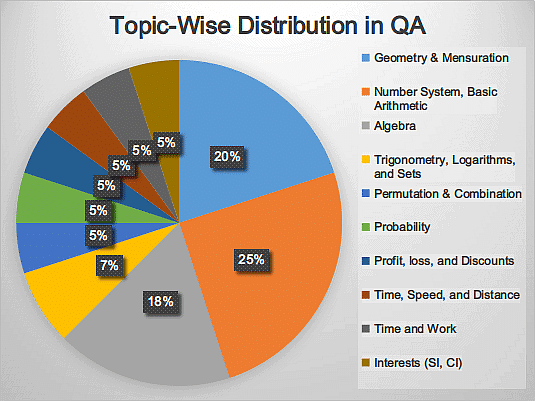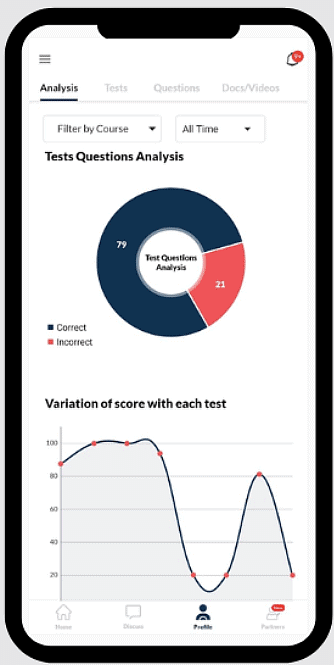How to prepare for Quantitative Aptitude for CAT | Quantitative Aptitude (Quant) PDF Download
Quantitative aptitude (QA) is often seen as one of the hardest sections in exams like CAT. Even though it uses basic math concepts from high school, tricky questions and limited time can make it hard for students to think clearly. To score 40+ in this section, practicing with the right questions is important. Before starting your preparation, it's essential to understand the section’s pattern, syllabus, key topics, and question types. This page gives you all the details, along with expert tips to help you prepare for QA.
- The quantitative ability section of CAT aims to test three things namely- numerical ability, mathematical skills and problem-solving skills.
- In general, the questions in the quantitative ability section of the CAT are related to elementary mathematics.
- In order to score good marks and clear the CAT cutoff, one needs to be completely acquainted with the fundamental concepts of solving questions.
- The purpose of this document is to help you understand how to read Quantitative Aptitude as a subject for not just CAT but also other B School entrances like SNAP, XAT, IIFT, NMAT, etc., and understand how to tackle the QA Section in these exams.
All the toppers recommend the LPA strategy – Learn, Practice & Analyse to score the maximum marks in the QA section. So, EduRev has made this Step-wise strategy for your complete preparation of the Quant section for CAT.
Step 0: Understanding the Exam Pattern and Syllabus for CAT
In CAT preparation, what and how much to learn is equally important. You can work hard, hustle, and put in the hours but the magic happens when you aim to perfect your skills beforehand.
- Understand Exam Pattern First: Out of 66 questions in the CAT exam, the Quant Section consists of 22 questions, and 6-8 questions in the section will be Non-MCQ type (without negative marking).
- Recent Trends: IIMs have started giving more emphasis on Arithmetic questions in the CAT entrance exam syllabus to promote diversity. While a maximum of 7-9 questions are from Arithmetic, 6-8 questions are from Algebra, and 4-5 questions are from topics like Geometry, Number systems, and Modern Math. You can find the number of questions with their weightage in the exam given below:

- CAT Syllabus: There's no defined syllabus of CAT but EduRev team has done exhaustive research from previous year papers & best books recommended by the toppers and have compiled the detailed CAT syllabus, you can check the syllabus here
CAT Syllabus Topics in Quant Section (with links):
- Algebra: Algebra, Linear Equations, Quadratic Equations, Inequalities, Functions, Progressions
- Arithmetic: Ratio and Proportion, Percentages, Profit and Loss, Interest (Simple and Compound), Mixtures and Allegations, Mixtures, Averages, Speed, Time, Distance, Pipes Cisterns & Time work.
- Number System:LCM and HCF, Number System, Logarithm, Surds and Indices
- Geometry: Trigonometry, Coordinate Geometry, Geometry/Mensuration
- Modern Math: Permutations and Combination, Probability, Set Theory
Step 1: Start with attempting Previous Year Papers

- It is highly recommended to attempt Previous Year Papers (PYQs) and a Mock test for the first 2-3 weeks to understand the type of CAT questions, their composition, subjects/topics which are being asked, and their format.
- It is recommended to go for a source that gives you topic-wise questions from previous year's papers. So that you can have a complete understanding of each topic and the type of questions asked. You can find these in a course of Topic-wise Past Year Questions for CAT on EduRev.
- You can get the last 10 years of the CAT exam from here: Previous Year Papers (PYQs).
Step 2: Prepare each topic according to its importance
- You need to first focus on the basic level questions instead of wasting time on complex topics. You can check out the practice tests on EduRev.

- Since you have seen the trends of the CAT exam above, you know that there are certain chapters that come more frequently than others. You should spend more time learning and more importantly practicing Algebra, Linear Equations, Quadratic Equations, Ratio and Proportion, Averages, Speed, Time, Distance, LCM and HCF, Number System, and Geometry/Mensuration.
- Though it is not recommended to leave any topic in your preparation you can definitely cover only important formulas in less asked chapters. EduRev gives you well-explained documents that cover the important formulas of each chapter.
Giving your learnings some time: You have to give time to what you have studied. It is not advised to read too much in one day. Also, the concepts that you have studied today, takes time to come natural to you while using them in solving questions.
Step 2.1: Perfect your Concepts through Video Lectures & Detailed Notes
- You should refer to a single source of notes & video lectures that will help you to strengthen the concepts and understand the same topic from a different perspective.
- This will give you a fair idea of the Quantitative Aptitude section and will help you to keep things in mind for a longer period of time.
- Regular revisions through notes and video lectures can help strengthen the basics and boost one’s confidence in the subject. You can get topic-wise notes & video lectures in the Quantitative Aptitude on EduRev, available on this link
- However, if you're a beginner & think that you need to work on your basic mathematical skills and have ample amount of time for the same, we recommend studying the basic NCERTs through this Mathematics NCERTs for CAT course on EduRev.
Step 2.2: Work on Shortcut Techniques
- On how to prepare for the CAT quantitative ability, the very first thing that comes to mind is - How to solve the questions accurately in such a limited time. Hence, in order to focus on time management for CAT, you must try to find ways of solving questions in a simplified yet rapid manner.
- It is important to understand and know which formula to apply to which question to solve it accurately and without letting go of time.

Step 2.3: Practice topic-wise tests
- Once the conceptual clarity of each topic is there, you must start practicing and solving more and more questions. Solving simple examples at first and then gradually moving toward the difficult questions would be helpful.
- You can prepare these topics by giving topic-wise tests for Arithmetic, Number systems, Geometry, Algebra, Modern Maths etc. on EduRev.
Step 3: Focus on Weak Areas
- After you have attempted tests, you need to analyze your tests and work on your weak areas
- For this, give a few sectional tests (your weaker section) from here on EduRev. After a few of them, you will figure out which questions are easy to solve, and which are the hard ones. Now you need to categorize them into easy, medium, and hard.
- EduRev algorithms also do this for you by categorizing the questions into easy, medium, and hard levels on the solutions page. It helps you to analyze if you are wasting time on hard questions or if you are getting the easy ones wrong.
- An analysis report is created at the end of each exam, which not only tells you all the questions you attempted right and wrong, but it also compares the time taken by you to attempt each question with the average time taken by other students. This analysis helps you not only improve your accuracy but also your speed, which is equally important in CAT. You can also see your progress in a particular area by applying a course and time filter.

- In the last few days, try to solve questions with a higher difficulty level. However, if they are still giving you a hard time then leave them and focus on solving the easy one in less time.
- To practice questions of a certain level of difficulty, you can make use of our dynamic tests, which allow you to create a test for yourself, here you can select the number of questions, the topic, the time, and the level of difficulty.
- During the exam, read every question but leave questions that are your weak points. Don’t waste your time solving them as they will eat up the time which you could have spent on other questions. The key here is to not skip a question even if it is from your weak topic, read every question- it might be an easy one.
Step 4: Set a timer for your Sectional Practice
- CAT will have sectional timing of 40 minutes to answer one section. You should try to solve the entire section by keeping an eye on the time.
- Better to move ahead of time as having a buffer time of a minimum of 5 to 10 minutes will leave room for revision on the exam day. CAT toppers suggest that you should mark important questions and concepts in order to have a quick revision during the final leg.
Practice sectional tests with a time limit for CAT, Click here.
Step 5: Solve a lot of CAT Mock Tests
It is important to work on the attempt rate first, that is, the number of questions you are able to attend in the given time, and then focus on improving your accuracy.
You would encounter 2 types of questions:
- Questions already seen or solved: These are the questions you have already seen or solved in mock tests or practice. You need to attempt these questions in the first attempt.
- Tricky questions: These are questions in which a tricky component is present. Here you might be able to understand most of the questions, but one part of it would take time to solve. Attempt these questions in the second attempt.
The framing and language of the questions asked in CAT are the same almost every year, and once you start giving a lot of tests, this trigger starts becoming repetitive. Being used to the language can help you remain calm during the exam.
- You can practice CAT mocks from the EduRev Platform with a time limit.
- Analyzing is very important after every test, EduRev automatically analyzes your results for you based on speed and accuracy.
Other Important Links:
1. Overall Understanding of Exam:
Check out these documents and prepare your strategy for CAT accordingly.
- CAT Syllabus 2024, Important topics & Changing trends of Exam
- Details about the CAT exam (Eligibility, Exam Pattern, Syllabus)
- How to attempt CAT on D-Day
- How to Prepare for CAT with EduRev
- FAQs about CAT Exam
2. Check out Subject-Wise Strategies
|
191 videos|131 docs|110 tests
|
Additional FAQs on How to prepare for Quantitative Aptitude for CAT - Quantitative Aptitude (Quant)
| 1. What is the exam pattern for the Quantitative Aptitude section of CAT? |  |
| 2. How can I identify my weak areas in Quantitative Aptitude for CAT preparation? |  |
| 3. How important are mock tests for preparing for the Quantitative Aptitude section of CAT? |  |
| 4. What topics should I prioritize while preparing for Quantitative Aptitude for CAT? |  |
| 5. How can I effectively manage my time during the Quantitative Aptitude section of CAT? |  |

|
Explore Courses for CAT exam
|

|















